 | ||||||
| Articles | Projects | Resume | Cartoons | Windsurfing | Paintings | Album |
Sooke River Twelve Month Baseline Water Quality Study for Salmonids
by Judith R. Burke

Waterose Environmental Services
Vancouver Island, BC

Section 2. Profile Continued
2.5 Wildlife
The SRW supports diverse wildlife including resident and migratory birds, aquatic waterfowl, migratory waterfowl, terrestrial mammals, and aquatic mammals. A species inventory has not been completed for this area. In recent years, the author has sighted bear, deer, raccoon, otter, bald and golden eagles, owls, blue heron, owls, turkey vultures, and many other birds and mammals in their natural habitat. In addition, the author has observed the marine life in the Sooke Harbour and basin while on frequent canoe trips throughout the seasons from the Harbour inlet up to the Sooke River Potholes. The late fall is exhilarating with salmon running and leaping, almost, into the canoe.
2.6 Fish
The focus of this study is on the lower SRW, which supports anadromous salmon, steelhead, and trout. The river system also supports other resident species, such as cutthroat trout, which are outside the focus of this study.
2.6.1 Fish Distribution
The types of fish habitat are illustrated in Figure 8. The map reference source is the Sooke Water Allocation Plan by Blecic and Jackson.
The fish barrier illustrated on the map just below Mary Vine Creek is the natural waterfall at the Sooke Potholes Provincial Park.
The lower SRW supports primarily Chum, Coho, and, Chinook salmon.
Figure 8. Map of Fish Habitat.
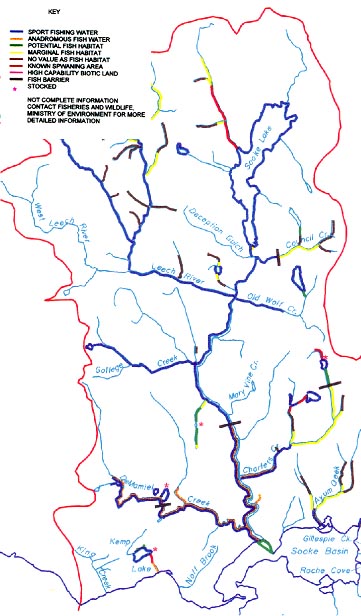
2.6.2 Fish Life Cycles
The generic life cycle model of salmon may be applied to all five species. The timing varies from species to species but the sequence of development is common. It is difficult to quantify information in narrow terms due to the wide variance in reported findings summarized in fish works.
Salmon are anadromous, which means that they spend a portion of their life cycle in both fresh and marine water. Salmon are semelparous, which means that they die after spawning to reproduce. Adults return to spawn. The females dig a nest in the gravel, which is called a redd. The male fertilizes the eggs with his sperm, or milt. The eggs in the redd are buried with gravel. Both male and female die after spawning. The fertilized eggs progress to the eyed stage and continue to incubate in the gravel until they are ready to hatch. When the alevins hatch, they obtain nourishment from the egg sag to develop to the point that they can swim. The alevins grow to a juvenile stage called fry and may still bear attached remnants of the egg sac but they are beginning to feed. The fry develop to the fingerling stage at which point they have lost all remnants of the egg sac and feed in the river environment. The fingerlings migrate and develop to the smolt stage, which refers to the physiological changes to adapt to a higher saline marine environment. The smolt develops the ability to osmoregulate water with higher saline concentrations. The mature smolt migrates to coastal waters and begins the ocean stage of the life cycle. The fish develops scales and characteristic camouflage colouring to survive in the ocean environment.
Mature adults return to their natal stream of birth primarily by means of olfactory acuity. Both the age of returning adults and time of return varies greatly between and within species and natal streams. The spawners often hover at the mouth of the natal stream until there is adequate water flow to enter and proceed to the spawning site. The adults undergo significant physiological transformations to complete the spawning phase of the reproduction cycle.
The following sections describe the life cycles of Chinook, Chum, and, Coho. The primary reference is Pacific Salmon Life Histories (Groot, 1991) and the graphics are from the Salmon Biology Graphics posted on the Department of Fisheries and Oceans Canada, Pacific Region, Website.
2.6.2.1 Chinook Salmon (Oncorhynchus tshawytscha)
The primary reference for this section is from "Life History of Chinook Salmon" by M.C. Healey (Healey, 1991) in Pacific Salmon Life Histories (Groot, 1991) unless otherwise referenced.
Chinook salmon, commonly called spring salmon, are the considered the third least abundant of the Pacific salmon. Chinook have a high commercial value, both for commercial fisheries and sports fishing, because Chinook are the largest of the salmon species. Chinook are not particularly abundant in the lower SRW. One distinguishing factor of Chinook is that the flesh colour includes both white and pink varieties. The typical adult Chinook is illustrated in Figure 9.
Figure 9. Chinook Salmon.
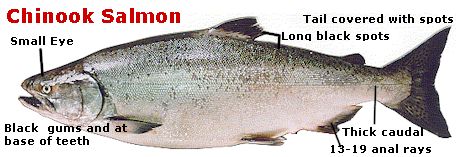
Healey presents the view that there are two distinct races of Chinook, the Stream-type, and the Ocean-type. Stream-type juveniles reside in fresh water streams for one or more years before migrating to marine waters. Ocean-type juveniles migrate to marine waters within three months of emergence. Ocean-type populations occur on the North American coast south of 56� N. Furthermore, Chinook partition utilization of upstream and downstream habitats.
The timing of the spawning runs vary from early spring to late fall. Spawning in the SRW occurs from September to November. The physical characteristics of the site selection for redds varies considerably for channel selection (side and main stem), flow 10 cm/s to 150 cm/s), depth (5 cm to 700 cm), and, substrate. The criteria for spawning habitat are summarized in Table 9.
Table 9. Spawning Criteria for Chinook Salmon.
|
Salmon Type |
Minimum Depth (m) |
Velocity (m/sec) |
Substrate Size (mm) |
Mean Redd Area (m2) |
Spawn Area per Pair (m2) |
|
Fall Chinook |
0.24 |
0.30-0.91 |
13-102 |
5.1 |
20.1 |
|
Spring Chinook |
0.24 |
0.30-0.91 |
13-102 |
3.3 |
13.4 |
|
Summer Chinook |
0.30 |
0.32-1.09 |
13-102 |
5.1 |
20.1 |
(Reference Source Whyte et al., 1997)
The fecundity of the females varies from 200- to 17,000 eggs and is less dependent on fish size than other salmon species. Many other factors reduce egg production and survival. Females may die before spawning or only partially spawn, which represents a relatively small portion of the total loss of egg potential. Chinook have the largest size eggs and therefore a smaller surface to volume ratio and require high oxygen concentration during incubation. Other egg losses can be attributed to eggs being swept away, eggs not fertilized, and, eggs not buried deeply enough. Once fertilized, the survival of the eggs can be reduced by flooding, siltation, predation, freezing, desiccation, and, disease.
The percolation of the gravel and the water quality are significant factors to the survival of the eggs during the period of incubation. Healey reports that mortality of eggs increased with decreased percolation rates: 2.9% mortality of eggs with percolation flows of 0.034 cm/s and 40% mortality of eggs with percolation flows at 0.0042 cm/s. Similarly, mortality rates increased with decreased oxygen concentration: 3.9% mortality of eggs at oxygen concentrations of 13 ppm and 40% mortality of eggs at oxygen concentrations of less than 5 ppm. Siltation, which is the accumulation of fine sediment particles in the interstitial pickets between gravel particles, reduces the dissolved oxygen available to the egg surface for metabolic processes for the egg to develop and emerge. Similarly, coarser gravel enhances survival of fry that emerge from the gravel in the early spring.
Emergence and downstream migration of fry occurs primarily during the night. The fry stage is characterized as juveniles with a fork length of 33-45 mm. At this point, they still have remnants of the egg sac. Fingerlings are juveniles with a fork length of 50-120 mm and are actively feeding on larval and adult insects in the river environment. The migration of the fingerlings from the point of emergence to the estuary occurs within three months of emergence and is usually complete by June.
The fingerlings reside in the estuary environment where the fresh water and the salt water mix, with typical salinity's ranging from 15-20 ppm. The fingerlings undergo a physiological change, smoltification, to adapt to the marine environment to develop the ability to osmoregulate water with higher saline concentrations. The smolts remain in the estuary until they are 70 mm fork length, usually with a residence time of 30 to 60 days, through June and July. Ocean-type Chinook have a longer residence time in the estuary environment than the stream-type Chinook. The Sooke River estuary provides important rearing habitat to Chinook and other local salmon species. When the smoltification transformation is complete, the Chinook are ready to begin their ocean journey.
The ocean-type Chinook tend to inhabit sheltered coastal waters in their first ocean year and they remain relatively close, within 1000 km of the natal stream. Mature Chinooks that return to spawn range from 2-6 years, with the average age about 4 years old.
2.6.2.2 Chum Salmon (O. keta)
The primary reference for this section is from "Life History of Chum Salmon" by E.A. Salo (Salo, 1991) in Pacific Salmon Life Histories (Groot, 1991) unless otherwise referenced.
Chum salmon, commonly called dog salmon, are the most widely distributed of the pacific salmon species. Chum salmon are the most abundant species in the lower SRW. They are the second largest salmon with adults averaging 3.5 to 4.5 kg. The typical adult Chum is illustrated in Figure 10.
Figure 10. Chum Salmon.
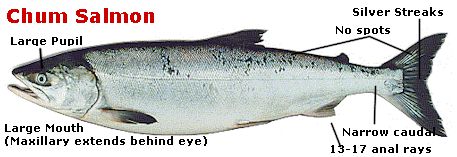
The spawning period in the SRW occurs from September to November with a peak period in October. In some areas, spawning occurs during the summer and autumn, depending on water flow.
Chum spawn above turbulent areas or areas of upwelling. The physical characteristics of the site selection for redds varies considerably for channel selection. Some of the variables and ranges are; low flow (10 cm/s to 170 cm/s), water depth (13 cm to 50 cm), substrate (0.5 cm diameter to 15 cm diameter), and, redd depth (20 cm to 50 cm). The criteria for spawning habitat are summarized in Table 10.
Table 10. Spawning Criteria for Chum Salmon.
|
Salmon Type |
Minimum Depth (m) |
Velocity (m/sec) |
Substrate Size (mm) |
Mean Redd Area (m2) |
Spawn Area per Pair (m2) |
|
Chum |
0.18 |
0.46-1.01 |
13-102 |
2.3 |
9.2 |
(Reference Source Whyte et al., 1997)
Chum salmon have adapted to spawning is shallower water and lower flows than some other species. In warmer climes, Chum can also spawn in intertidal areas. The overall male to female ratio is 1 to 1. The fecundity of the females varies from 2000 to 4000 eggs and varies depending on time of return, stream-length, and, stream conditions. Egg size increases from north to south and correlates to female size. Southern stocks incubate at higher temperatures, have a higher metabolic rate, and therefore require more energy. The females may dig four to six redds. The males compete to fertilize the eggs. The females cover and defend the redds while the males are transitory.
The incubation and emergence time is dependent on stream flow, dissolved oxygen, gravel composition, spawning time, spawning density, genetics, and, water temperature. Water temperature is monitored in temperature units or TUs. TU = the average number of degrees above 0�C during a 24 hour period. Near freezing temperatures can reduce egg production and survival. Chum requires 400 to 600 TUs to hatch and 700 to 1000 TUs for yolk absorption.
Many other factors reduce egg production and survival. Females may die before spawning or only partially spawn, which represents a relatively small portion of the total loss of egg potential. Other egg losses can be attributed to eggs being swept away, eggs not fertilized, and, eggs not buried deeply enough. Once fertilized, the survival of the eggs can be reduced by flooding, siltation, predation, freezing, desiccation, and, disease.
The percolation of the gravel and the water quality are significant factors to the survival of the eggs during the period of incubation. The survival of the eggs and alevin is directly related to intragravel dissolved oxygen levels. Salo writes that the lethal intragravel level is 1.67 mg/L dissolved oxygen concentration and that fatality is high at concentrations less than 2 mg/L. While Chum have lower oxygen requirements than Coho or Steelhead, low levels of dissolved oxygen at early stages of development can cause monstrosities.
The composition of the gravel and excess sedimentation has an impact on the survival of the eggs. Sedimentation causes direct suffocation of eggs and alevins, reduces intragravel water flows and levels of dissolved oxygen, and creates a physical barrier to emergence. Survival rates are higher in larger gravel with 5.1 to 10.2 cm diameters.
Emergence occurs primarily during the night, primarily in early spring during March and April in the SRW. The fry migrate to the estuary shortly after emergence, where they will adapt to the saline environment in the intertidal brackish waters. The size may vary from 29 to 107 mm in length, but are usually less than 70 mm in length. Smoltification usually occurs at 50 to 80 mm in length.
Chum salmon are characterized as highly opportunistic feeders. The early diet includes insect larvae and small insects and diversifies in the estuary to feeding on larger insects, small fish, and marine organisms at high tide. Chum salmon are highly dependent on the Sooke River estuary, and may take up residence for several weeks. The Chum will move seaward when food supplies decline, which is usually correlated to the outflow of plankton bloom in warmer temperatures. In the ocean, Chum feed on marine zooplankton, fish, and squid larvae. Immature Chum tends to remain near shore and the mature ocean Chum migrates further offshore. Most Chum mature in 3 to 5 years and can average 5.34 kg.
Chum are a highly adaptive species, comprise the largest biomass of the salmon species, and play an integral role in recycling significant quantities of nutrients from the ocean back into the terrestrial ecosystem.
2.6.2.3 Coho salmon (O. kisutch)
The primary reference source for this section is from "Life History of Coho Salmon" by F.K. Sandercock (Sandercock, 1991) in Pacific Salmon Life Histories (Groot, 1991) unless otherwise indicated.
Coho salmon are valued by both the commercial fishing industry and the sports fishing industry; Coho have highly prized red meat and are an aggressive catch. Coho are the most widespread of the five salmon species in British Columbia. They are easily adapted to hatchery rearing and commercial fish farming. The average adult ranges from 2.7 to 5.4 kg. The typical adult Coho is illustrated in Figure 11.
Figure 11. Coho Salmon.
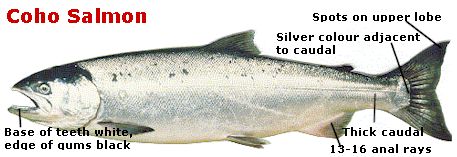
They are also characterized as a highly opportunistic species and can navigate difficult obstacles, by sometimes spectacular means, to reach headwaters for spawning. Coho are known to jump and break the surface of the water. Coho tend to migrate further upstream than Chum and historic records indicate that De Mamiel Creek has a higher Coho population than the Sooke River. Spawning usually occurs from September to November, with a period of peaking in October, depending on the fall rains and stream flows. Coho prefer migration temperatures of 7.2 to15.0 �C. Groundwater seepage can sometimes moderate temperature extremes.
Most Coho mature in their third year. The male to female ratio of mature adults is usually 1 to 1, except for excess younger males, called Jacks. The fecundity of the females in BC is approximately 2700 eggs per female. The egg size is relatively small, 4.5 to 6.0 mm diameter.
Coho are tolerant of a wide range of stream characteristics and spawn in small streams, preferably at the head of a riffle. Some typical characteristics include: stream less than 1 m wide, flow of 5.0 to 6.8 m3/s, and substrate gravel greater than 15 cm diameter. The criteria for spawning habitat are summarized in Table 11.
Table 11. Spawning Criteria for Coho Salmon.
|
Salmon Type |
Minimum Depth (m) |
Velocity (m/sec) |
Substrate Size (mm) |
Mean Redd Area (m2) |
Spawn Area per Pair (m2) |
|
Coho |
0.18 |
0.30-0.55 |
>130 |
1.5-2.8 |
11.7 |
(Reference Source Whyte et al., 1997)
The female Coho dig several redds and mate with the dominant male. The female buries the eggs and can remain up to ten days after spawning. Incubation time to emergence varies depending on temperature. While Coho have a high fertilization rate, the eggs are vulnerable to winter flooding, siltation, sedimentation causing reduced concentrations of dissolved oxygen, low flows, freezing, bird and insect predation, and, infections. Under average conditions, 15 to 27% will survive to emergence.
At emergence, the fry are vulnerable to wash out by spring freshets. Fry take shelter in the interstitial gravel spaces, under stones, and any niche that can provide shelter. They seek out cut banks and rear in shaded pools. They are characterized as territorial, particularly in faster waters. Coho fry are active daylight hunters, feeding visually on insects. The most productive Coho areas are small streams rather than large rivers because small streams have the highest proportion of marginal slack water to midstream area. Insects in the midstream are not considered available as food, therefore wider streams equal a greater food loss to the Coho. Furthermore, there are usually higher insect populations at the stream bank in shaded streams. Coho prefer streams with a pool to riffle sequence of 1 to 1, as these are the most productive for food. Coho eat mostly large insects and the yearlings can feed on small fish fry. The Coho do not feed during the night and sink to the bottom of the stream.
Abundance of Coho is limited by availability of suitable territories. Increased stream complexing provides more habitat and supports more fry. Pools of 10 to 80 m3 or 52-250 m2 are optimal for Coho production. Production capacity per 100 m2 wetted stream can vary from 18 to 67 smolts. Side channels can yield 125 to 141 smolts per 100 m2. The number of smolts produced per female is 7 to 10 times greater in streams than in lakes.
The fingerlings reduce feeding activity in the late summer or early fall. They move to deeper pools with overhanging logs, side channels, and, stable tributaries. Metabolism and swimming speeds slow down, and by December, they prefer depths of greater than 45 cm and slower water velocities.
The survival of Coho fry is greatly enhanced by access to over wintering and rearing habitat, which provides food and shelter. Extreme winter flows can cause uneven distribution of food resources. Juvenile Coho are also vulnerable to predation from other fish, birds, and, mammals.
Coho under yearlings that are washed prematurely into the marine environment by spring freshets or flooding cannot survive in the saltwater. The threshold size for tolerance and survival of salt water is 7 to 8 cm. Smolt migration usually occurs at night from March to May. The optimal size is 10 to 11 cm fork length. At this time, the smolts are vulnerable to predation by marine organisms. Coho grow rapidly in the estuary environment to 14 to 22cm.
The Coho stay near shore for several months, depending on the food supply, before they migrate north over the continental shelf. They usually stay within 150 km of the shoreline and in depths less than 90 m. Juvenile Coho initially feed on marine invertebrates but become piscivorous, eating other fish species, including chum and Pink salmon fry. There is about a 5% survival rate for smolt to adult stage. They can spend twelve months at sea, before migrating south to their natal stream.
DFO has sponsored programs to track the returns or escapements of Coho for fish hatchery raised fish. A coded wire tag is inserted into the nose cartilage of the fish and the adipose fin is clipped prior to releasing the fish to the wild. The heads of salmon that return to the spawning grounds with clipped adipose fins are submitted to the lab for identification. This program has revealed that hatchery raised fish return to the point of their release.
2.6.3 Fish Escapements
The fish escapements are listed in Table 12. The data is based on DFO records of fish enumerated by a variety of sources and methods. There are information gaps for years with no recorded observations. These estimates include the lower Sooke River, DeMamiel Creek, and Charters River.
Table 12. Lower SRW Salmon Escapements 1953 to1998.
|
Year |
Chinook |
Chum |
Coho |
|||||||||
|
Year |
Sooke |
DeMamiel |
Charters |
Total |
Sooke |
DeMamiel |
Charters |
Total |
Sooke |
DeMamiel |
Charters |
Total |
|
1953 |
0 |
35000 |
15000 |
50000 |
400 |
400 |
800 |
|||||
|
1954 |
75 |
75 |
35000 |
7500 |
42500 |
200 |
1500 |
1700 |
||||
|
1955 |
25 |
25 |
35000 |
15000 |
50000 |
75 |
75 |
150 |
||||
|
1956 |
0 |
15000 |
7500 |
22500 |
25 |
400 |
425 |
|||||
|
1957 |
25 |
25 |
15000 |
7500 |
22500 |
200 |
400 |
600 |
||||
|
1958 |
200 |
200 |
35000 |
35000 |
70000 |
200 |
3500 |
3700 |
||||
|
1959 |
200 |
200 |
15000 |
7500 |
22500 |
200 |
750 |
950 |
||||
|
1960 |
400 |
400 |
3500 |
3500 |
7000 |
200 |
200 |
400 |
||||
|
1961 |
200 |
200 |
3500 |
3500 |
7000 |
200 |
3500 |
3700 |
||||
|
1962 |
750 |
750 |
3500 |
3500 |
7000 |
400 |
3500 |
3900 |
||||
|
1963 |
1500 |
1500 |
7500 |
3500 |
11000 |
200 |
3500 |
3700 |
||||
|
1964 |
750 |
750 |
35000 |
15000 |
50000 |
75 |
1500 |
1575 |
||||
|
1965 |
400 |
400 |
7500 |
7500 |
15000 |
25 |
3500 |
3525 |
||||
|
1966 |
750 |
750 |
7500 |
7500 |
15000 |
25 |
7500 |
7525 |
||||
|
1967 |
1500 |
1500 |
35000 |
7500 |
42500 |
25 |
750 |
775 |
||||
|
1968 |
3500 |
3500 |
35000 |
35000 |
70000 |
75 |
3500 |
3575 |
||||
|
1969 |
1500 |
1500 |
35000 |
15000 |
50000 |
750 |
750 |
|||||
|
1970 |
1500 |
1500 |
35000 |
15000 |
50000 |
25 |
3500 |
3525 |
||||
|
1971 |
750 |
750 |
15000 |
7500 |
22500 |
75 |
1500 |
1575 |
||||
|
1972 |
200 |
200 |
75000 |
15000 |
90000 |
200 |
3500 |
3700 |
||||
|
1973 |
3500 |
3500 |
75000 |
35000 |
110000 |
400 |
6400 |
6800 |
||||
|
1974 |
200 |
2 |
202 |
15000 |
3500 |
18500 |
75 |
1500 |
1575 |
|||
|
1975 |
400 |
400 |
3500 |
3500 |
7000 |
200 |
750 |
950 |
||||
|
1976 |
30 |
30 |
3500 |
1500 |
5000 |
25 |
400 |
425 |
||||
|
1977 |
25 |
25 |
50 |
7500 |
3500 |
11000 |
75 |
750 |
825 |
|||
|
1978 |
6 |
15 |
21 |
9500 |
8000 |
17500 |
100 |
800 |
900 |
|||
|
1979 |
45 |
12 |
57 |
4500 |
800 |
5300 |
40 |
1200 |
1240 |
|||
|
1980 |
36 |
36 |
14500 |
9000 |
2300 |
25800 |
5 |
800 |
57 |
862 |
||
|
1981 |
30 |
30 |
11000 |
6000 |
1400 |
18400 |
800 |
800 |
||||
|
1982 |
3 |
3 |
8000 |
2500 |
1300 |
11800 |
6 |
700 |
13 |
719 |
||
|
1983 |
18 |
18 |
9000 |
8000 |
1100 |
18100 |
230 |
230 |
||||
|
1984 |
400 |
400 |
12000 |
8000 |
670 |
20670 |
120 |
365 |
8 |
493 |
||
|
1985 |
400 |
4 |
3 |
407 |
35000 |
11000 |
900 |
46900 |
9 |
700 |
4 |
713 |
|
1986 |
112 |
112 |
40000 |
1900 |
900 |
42800 |
40 |
862 |
7 |
909 |
||
|
1987 |
250 |
250 |
25000 |
4980 |
1000 |
30980 |
1340 |
14 |
1354 |
|||
|
1988 |
250 |
28 |
278 |
60000 |
44000 |
3500 |
107500 |
350 |
350 |
|||
|
1989 |
110 |
6 |
116 |
10000 |
3300 |
300 |
13600 |
780 |
780 |
|||
|
1990 |
800 |
4 |
804 |
8700 |
3500 |
420 |
12620 |
700 |
700 |
|||
|
1991 |
450 |
450 |
7000 |
1633 |
8633 |
703 |
703 |
|||||
|
1992 |
128 |
2 |
130 |
45000 |
15000 |
1500 |
61500 |
4 |
800 |
0 |
804 |
|
|
1993 |
97 |
97 |
20000 |
10000 |
1500 |
31500 |
22 |
610 |
0 |
632 |
||
|
1994 |
29 |
9 |
38 |
20000 |
6000 |
1100 |
27100 |
4 |
600 |
604 |
||
|
1995 |
650 |
650 |
- |
- |
||||||||
|
1996 |
10 |
15 |
25 |
15000 |
7000 |
450 |
22450 |
80 |
280 |
20 |
380 |
|
|
1997 |
1050 |
210 |
150 |
1410 |
25000 |
11000 |
1700 |
37700 |
60 |
350 |
12 |
422 |
|
1998 |
2100 |
2 |
2102 |
60000 |
55000 |
1000 |
116000 |
122 |
950 |
50 |
1122 |
|
The total escapements from 1953 to 1998 for Chinook, Chum, and Coho are illustrated in Figure 12.
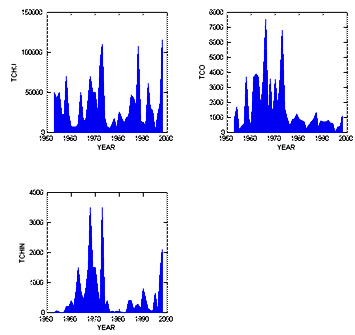
TCHU = Total Chum Escapements
TCO = Total Coho Escapements
TCHIN = Total Chinook Escapements
The following graphs illustrate the subsets of escapements of Chinook, Chum, and, Coho in the lower Sooke River, DeMamiel Creek, Charters River, and the total subset for the three locations.
Chinook Escapements.
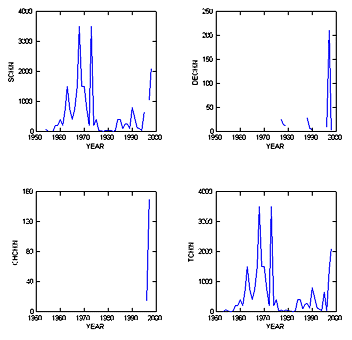
DECHIN = DeMamiel Creek Chinook Escapements
CHCHIN = Charters River Chinook Escapements
TCHIN = Total Chinook Escapements
Chum Escapements.
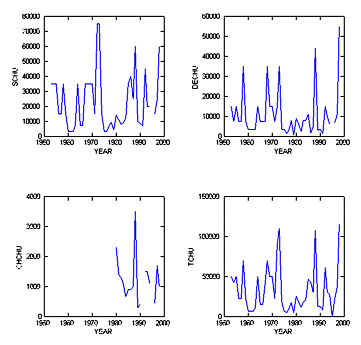
DECHU = DeMamiel Creek Chum Escapements
CHCHU = Charters River Chum Escapements
TCHU = Total Chum Escapements
Coho Escapements.
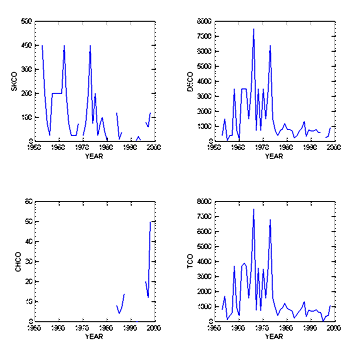
DECO = DeMamiel Creek Coho Escapements
CHCO = Charters River Coho Escapements
TCO = Total Coho Escapements
Next Section 3. Methods
Back to Table of Contents
For more information about the Sooke River Watershed:
 Email Judith Burke at Waterose Environmental Services
Email Judith Burke at Waterose Environmental Services

Other Water Quality Projects by Waterose:
Water Quality Tests Offered by Waterose
Twelve Month Baseline Water Quality Study for Salmonids in the lower Sooke River Watershed (Victoria Times Colonist Enviro News)
Twelve Month Baseline Water Quality Study for Salmonids in the lower Sooke River Watershed (Sooke Mirror)
Water Quality Project on Musqueam Salmon Stream in Urban Vancouver
Analysis of Coliforms and Nutrients in surface waters flowing into Esquimalt Lagoon
Water Quality Monitoring on Ayum Creek, a wild salmon and trout bearing stream, for Society for the Protection of Ayum Creek and Fisheries and Oceans, Canada
Testing the Waters
Story in Sooke News Mirror, March 28, 2001 about the Automated Water Quality Monitoring Project

 email Waterose
email Waterose
Please Sign My Guestbook
Please View My Guestbook

| Articles | Projects | Resume | Cartoons | Windsurfing | Paintings | Album |
 | ||||||